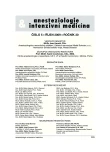Age of packed red blood cells and its influence on concentration of selected biochemical values
Authors:
Uvízl Radovan; Fritscherová Šárka; Neiser Jan; Šafránek Petr; Adamus Milan
Authors‘ workplace:
Klinika anesteziologie a resuscitace, Fakultní nemocnice Olomouc
Published in:
Anest. intenziv. Med., 20, 2009, č. 5, s. 257-261
Category:
Intensive Care Medicine - Original Paper
Overview
Objective:
Administration of blood transfusion is associated with risk and adverse effects. Large-volume transfusion can cause electrolyte and acid-base balance disturbances. The influence of metabolism and decomposition of erythrocytes in the transfusion unit can change the initial values of some biochemical parameters; the age of the transfusion unit may play the major role. The aim of this study was to describe the influence of the age of the transfusion unit of packed red blood cell (PRBC) on biochemical values in vitro.
Design:
Prospective observational study.
Setting:
Multidisciplinary intensive care unit (ICU) in a tertiary care centre.
Materials and methods:
We examined samples from 80 PRBC units of different age (the expiration process is defined by national and local hospital standards). The samples originated from the transfusion department where PRBCs were stored in standard conditions. The samples were analysed by a standard-controlled analyser (Critical Care Xpress®, Nova Biomedical) and we recorded the data about the biochemical values in dependence on the PRBC age.
Results:
We found that PRBC age determines a rise of K+ and lactate values and a decrease in pH, Na+ and glycaemia. The measured values were in the range of: potassium 4.0–40.5 mmol/l; lactate 4.1–28.0 mmol/l; pH 7.0–6.65; glycaemia 29.0–14.0 mmol/l; sodium 137–116 mmol/l. Calcium concentration remained stable.
Conclusion:
The administration of large-volume blood transfusion, particularly close to the expiry date of the PRBC unit, can pose a significant risk of possible disturbances in the electrolyte and acid-base balance of the patient.
Keywords:
erythrocyte – PRBC – hyperkalaemia – lactate – metabolic acidosis
Sources
1. Brecher, M. E. Noninfectious complications of blood transfusion. AABB technical manual, 2005, p. 577–600.
2. Cetkovský, P. et al. Intenzivní péče v hematologii. 1. vydání, Praha: Galén, 2004, p. 169–179. ISBN 80-7262-255-2.
3. Hillyer, C. D., Hillyer, K. L., Strobl, F. J., Jefferies, L. C., Silberstein, L. E. Handbook of transfusion medicine. Academic Press, 2001, p. 275–282.
4. Sever, M. S., Erek, E., Vanholder, R., Kantarci, G. Serum potassium in the crush syndrome victims of the Marmara disaster. Clin. Nephrol., 2003, p. 59.
5. Larsen, R. Anestezie. 7. vydání, Praha: Grada, 2004, p. 718–753. ISBN 80-247-0476-5.
6. Rose, B. D., Post, T. W. Clinical Physiology of Acid – Base and Electrolyte Disorders. 5th ed. New York: McGraw-Hill, 2001, p. 383–396, 898–910.
7. Raghavan, M., Marik, P.E. Anemia, allogenic blood transfusion, and immunomodulation in the critically ill. Chest, 2005, 127, p. 295–307.
8. Toy, P., Popovsky, M. A., Abraham, E., et al. Transfusion-related acute lung injury: Definition and review. Crit. Care Med., 2005, 33, p. 721–726.
9. Fergusson, D., Khanna, M. P., Tinmouth, A., et al Transfusion of leukoreduced red blood cells may decrease postoperative infections: Two meta-analyses of randomized controlled trials. Can. J. Anaesth., 2004, 51, p. 417–424.
10. Hebert, P. C., Tinmouth, A., Corwin, H. L. Controversies in RBC transfusion in the critically ill. Chest, 2007, 131, p. 1583–1590.
11. Consensus conference: Perioperative red blood cel transfusion. JAMA, 1988, 260, p. 2700–2703.
12. Guidelines for red blood cell and plasma transfusion for adults and children. Expert Working Group. Can. Med. Assoc. J., 2008, 156, 11 suppl., p. S1–S24.
13. Marik, P. E., Corwin, H. L. Efficacy of red blood cell transfusion in the critically ill. A systematic review of the literature. Crit. Care Med., 2008, 36, 9, p. 2667–2674.
14. Vítovec, J., Špinar, J. Intenzivní péče v kardiologii. IPVZ : Brno, 1994, p. 150. ISBN 80-7013-170-5.
15. Aboudara, M. C., Hurst, F. P., Abbott, K. C., Perkins, R. M. Hyperkalemia after packed red blood cell transfusion in trauma patients. J. Trauma, 2008, 64, 2 Suppl., p. S86–91.
16. Hillyer, C. D., Hyllier, K. L., Strobl, F. J., Jefferies, L. C., Silberstein, L. E. Handbook of transfusion medicine. Academic press, 2001, p. 263–271.
17. Smith, H. M., Farrow, S. J., Ackerman, J. D., Stubbs, J. R., Sprung, J. Cardiac arrest associated with hyperkalemia during red blood cell transfusion: a case series. Anesth. Analg., 2008, 106, 4, p. 1062–1069.
Labels
Anaesthesiology, Resuscitation and Inten Intensive Care MedicineArticle was published in
Anaesthesiology and Intensive Care Medicine

2009 Issue 5
Most read in this issue
- Induction and recovery times for general anaesthesia – a prospective study
- Cancellations of scheduled surgical procedures in three Czech university hospitals – a prospective study
- Regional citrate anticoagulation during continuous renal replacement therapy (CRRT) in a cardiac surgery patient with a high risk of bleeding – case report
- Age of packed red blood cells and its influence on concentration of selected biochemical values
